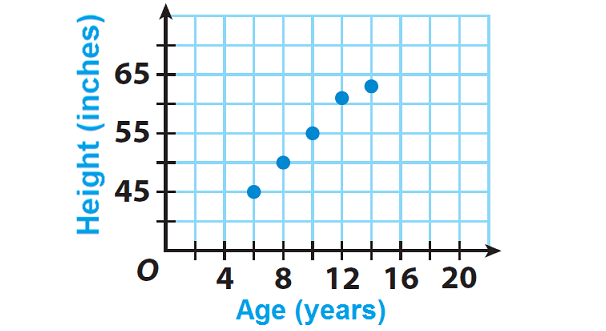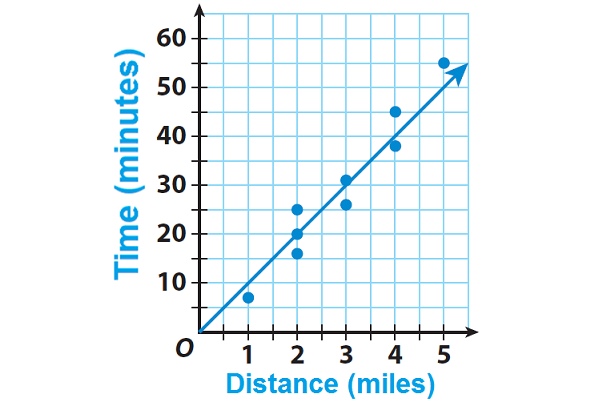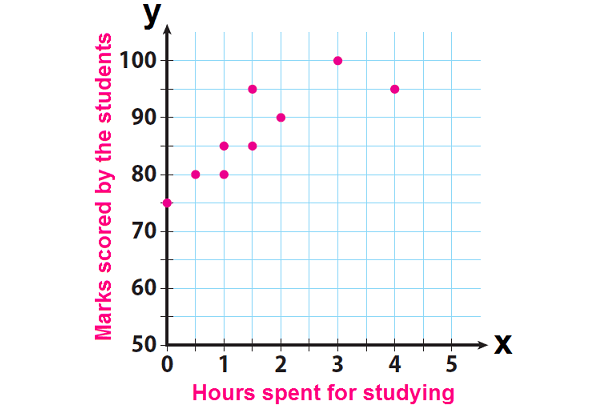MAKING A SCATTER PLOT WORKSHEET
Subscribe to our ▶️ YouTube channel 🔴 for the latest videos, updates, and tips.
Question 1 :
The final question on a science test reads, how many hours spent studying for this test. The teacher records the number of hours each student studied and the marks scored by the respective student on the test.
Hours Spent for Studying
0
0.5
1
1
1.5
1.5
2
3
4
Marks Scored by the Students
75
80
80
85
85
95
90
100
90
Describe the type of association between number of hours spent for studying and marks scored using scatter plot.
Question 2 :
What trend can we see in the data given in question 1 ?
Question 3 :
Can we conclude the grade associated with studying for 10 hours would follow the trend in question 2 ?
Question 4 :
Can we say the relationship given in question 1 as positive or negative ?
Question 5 :
The scatter plot shows David’s height at various ages. Describe the type of association between David’s age and his height. Explain.

Question 6 :
Alexa is training for a 10K race. For each of her training runs, she recorded the distance she ran and the time she ran. She made a scatter plot of her data and drew a trend line. Use the trend line to predict how long it would take Alexa to run 4.5 miles.


Question 1 :
The final question on a science test reads, how many hours spent studying for this test. The teacher records the number of hours each student studied and the marks scored by the respective student on the test.
Hours Spent for Studying
0
0.5
1
1
1.5
1.5
2
3
4
Marks Scored by the Students
75
80
80
85
85
95
90
100
90
Describe the type of association between number of hours spent for studying and marks scored using scatter plot.
Answer :
Step 1 :
Make a prediction about the relationship between the number of hours spent studying and marks scored.
When we look at the above data, we can make the following prediction. A greater number of study hours are likely to be associated with higher marks.
Step 2 :
Make a scatter plot. Graph hours spent studying as the independent variable and marks scored by the students as the dependent variable.
Moreover, if we consider hours spent for studying as variable "x" and marks scored by the students as variable "y", we can write the above data as ordered pairs in the form (x, y).
Then, we have
(0, 75), (0.5, 80), (1, 80), (1, 85), (1.5, 85), (1.5, 95), (2, 90), (3, 100) and (4, 90).
Plot these points on a graph paper.

The graph shows a general upward trend. So the association between number of hours spent for studying and marks scored is positive. That is, as number of hours is getting increased, the marks scored is also getting increased.
Question 2 :
What trend can we see in the data given in question 1 ?
Answer :
In general, when students increase the number of study hours, the marks scored by them are also getting increased.
Question 3 :
Can we conclude the grade associated with studying for 10 hours would follow the trend in question 2 ?
Answer :
No
The graph shows a general upward trend, but the marks scored by the students cannot exceed 100.
Question 4 :
Can we say the relationship given in question 1 as positive or negative ?
Answer :
Yes, it is positive
Because, when one variable (x) is increased, the other variable (y) is also getting increased.
Question 5 :
The scatter plot shows David’s height at various ages. Describe the type of association between David’s age and his height. Explain.

Answer :
As David is getting older, his height increases roughly along a straight line on the graph, so the association is positive and basically linear.
Question 6 :
Alexa is training for a 10K race. For each of her training runs, she recorded the distance she ran and the time she ran. She made a scatter plot of her data and drew a trend line. Use the trend line to predict how long it would take Alexa to run 4.5 miles.

Answer :
For a distance of 4.5 miles, the trend line shows a time of 45 minutes. So, it will take Alexa about 45 minutes to run 4.5 miles.
Subscribe to our ▶️ YouTube channel 🔴 for the latest videos, updates, and tips.
Kindly mail your feedback to v4formath@gmail.com
We always appreciate your feedback.
About Us | Contact Us | Privacy Policy
©All rights reserved. onlinemath4all.com

Recent Articles
-
Times Table Shortcuts
Dec 30, 25 07:14 PM
Times Table Shortcuts - Concept - Examples -
10 Hard SAT Math Questions (Part - 42)
Dec 30, 25 05:52 AM
10 Hard SAT Math Questions (Part - 42) -
10 Hard SAT Math Questions (Part - 38)
Dec 29, 25 04:21 AM
10 Hard SAT Math Questions (Part - 38)

